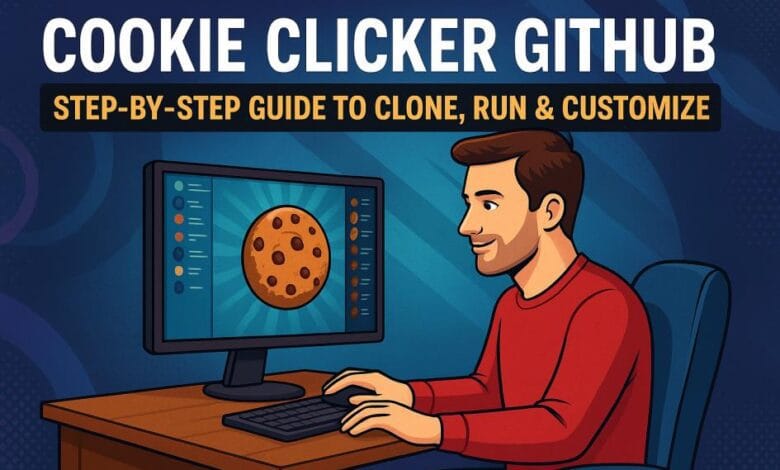Cookie Clicker GitHub: Step‑by‑Step Guide to Clone, Run & Customize

Introduction
Cookie Clicker, the ever-popular incremental game, has enthralled players worldwide with its deceptively simple mechanic and deep strategy.
The cookie clicker github repository brings this browser-based phenomenon to your local environment, exposing the entire codebase and empowering you to experiment, customize, and learn.
This detailed guide will take you through the process of accessing, running, and improving Cookie Clicker, all without needing any outside hosting services.
Why Choose the Cookie Clicker GitHub Version? Key Benefits
Choosing the cookie clicker github path unlocks several compelling advantages:
- Full Transparency: Gain insight into game mechanics, from cookie generation to special events, by viewing the underlying implementation. This level of visibility is unavailable in closed-source or static-hosted versions.
- Community Collaboration: The GitHub ecosystem thrives on contributions. Bug fixes, performance enhancements, and creative mods flow in continuously, ensuring you always have the latest improvements to explore.
- Rich Customization: Tailor every aspect of the game visual themes, upgrade costs, and even new building types by editing specific sections of the repository. This playground fosters creativity and deepens your understanding of incremental design.
- Offline Accessibility: Play wherever you are, even without an internet connection. Cloning the repo and running it locally eliminates network latency and server restrictions.
- Learning Tool: The open-source code of Cookie Clicker serves as a practical example for developers to understand modular JavaScript, how to create an event-driven user interface, and methods for improving performance.
- Contribution Opportunities: Strengthen your GitHub portfolio by fixing issues or adding features. Peer-reviewed contributions build your reputation and connect you with a passionate community of idle-game enthusiasts.
Prerequisites: What You Need Before Cloning “cookie clicker github”
Before diving in, prepare your environment:
- Version Control Tool: Make sure you have a client installed that can clone and manage Git repositories.
- JavaScript Runtime: An up-to-date runtime environment is required to handle build scripts and local hosting.
- Development Editor: A modern code editor will help you navigate and modify the project files efficiently.
- Basic JavaScript Familiarity: Understanding fundamental scripting concepts will ease your exploration and customization of game logic.
- Local Server Utility: To avoid browser restrictions, set up a simple local server tool that can serve files over HTTP.
Armed with these tools, you’ll be ready to bring the repository to life.
Step 1: How to Fork and Clone the Cookie Clicker GitHub Repository
The first step in harnessing cookie clicker github is creating your own copy and bringing it to your workstation:
- Fork the Official Repository: Create a personal fork in your GitHub account. This grants you a private workspace to experiment without affecting the original code.
- Clone to Your Machine: Using your version control tool, clone the fork onto your local drive. This gives you a complete snapshot of the project files and history.
- Configure Upstream Sync: Link the original repository as an upstream source so you can fetch and merge future updates, ensuring your copy stays current with ongoing developments.
Step 2: Installing Dependencies for Your Local Build
With the code on your machine, the next task is to install all necessary libraries and tools:
- Inspect Dependency List: Review the project’s dependency manifest to understand which tools and libraries are required.
- Perform Installation: Use your package manager to download and configure all dependencies into the project folder. Watch for any warnings or missing dependencies.
- Verify Installation: Confirm that the dependencies folder exists and aligns with the manifest, indicating a successful setup.
Once dependencies are in place, your local copy is ready to run.
Step 3: Running Cookie Clicker Locally—Quick Start Demo
To start your own Cookie Clicker game, you just need to follow some easy steps:
- Start the Serving Process: Invoke the local server script to host the game files over a browser-accessible URL.
- Open in Browser: Navigate to the specified local address to see Cookie Clicker’s interface load directly from your computer.
- Interact and Test: Click cookies, purchase upgrades, and observe special events as they trigger. Monitor the browser console for any warnings that might indicate missing assets.
Running locally ensures smooth performance and immediate feedback during any modifications.
Step 4: Customizing Cookie Clicker GitHub—Themes, Mods & Tweaks
A major attraction of cookie clicker GitHub is the ability to personalize it.
Changing Visual Themes
Identify the theme-related files and adjust colors, fonts, and layout to craft a new look. Apply your theme selection to see updates in real time.
Adding Mods and Features
Integrate community-created or self-authored modules to automate actions, track advanced statistics, or introduce mini-games. Enable or disable mods through configuration settings.
Tweaking Game Parameters
Locate the configuration sections that define cookie values, upgrade costs, and event probabilities. Modify these parameters to create a faster or more challenging gameplay experience.
Extending Functionality
Beyond superficial changes, you can implement entirely new building types, achievements, or interactive features. Document your enhancements clearly to maintain readability for others.
Step 5: Troubleshooting Common “cookie clicker github” Errors
Even skilled developers run into issues. Here’s how to address the most frequent problems:
- Missing File or Module Errors: Check for typos in file names and ensure all dependencies are correctly installed.
- Version Conflicts: Align your dependency versions with the project’s recommendations to avoid mismatches.
- Port Conflicts: If the local server fails to start due to an occupied port, choose an alternative port or close the conflicting service.
- Loading Restrictions: Always use a local HTTP server to prevent browser security restrictions from blocking assets.
Regularly syncing with the upstream repository and using version control branches will minimize disruption from experimental changes.
Advanced Tips: Automating Clicks, Adding Features & Performance Hacks
Once comfortable with the basics, explore these advanced techniques:
- Automated Testing: Use script-based automation to simulate gameplay loops, validating functionality under stress.
- Data Visualization: Incorporate chart tools to graph cookie production rates over time, offering insights into your custom mechanics.
- Performance Tuning: Implement lazy loading, asset compression, and module splitting to optimize load times and runtime performance.
- Multiplayer Experiments: Prototype real-time synchronization between multiple browsers to explore collaborative or competitive play modes.
How to Contribute Back to Cookie Clicker GitHub: Pull Requests & Best Practices
Enhance your open-source journey with thoughtful contributions:
- Pick an Issue: Look for tasks labeled for newcomers or high-impact improvements.
- Synchronize Your Fork: Ensure your workspace reflects the latest official updates.
- Develop on a Branch: Isolate your changes for clarity and ease of review.
- Test Thoroughly: Validate functionality across scenarios before submitting.
- Craft Descriptive Descriptions: In your contribution request, clearly explain the problem addressed, steps to test, and any visual evidence.
- Engage with Feedback: Respond constructively to reviewers and iterate until your contribution meets the project’s standards.
Conclusion: Your Next Steps with Cookie Clicker GitHub
You have an excellent guide ready for becoming skilled at cookie clicker on GitHub:
- Leverage transparency to learn core game mechanics.
- Empower your creativity with customization and advanced features.
- Maintain stability through proactive troubleshooting.
- Enrich the community by contributing improvements.
Embrace experimentation and share your unique creations. The cookie clicker github repository stands ready to evolve with your ideas.
Frequently Asked Questions About Cookie Clicker GitHub
Is this the original source code for Cookie Clicker?
Yes, the GitHub repository represents the primary open-source implementation, often maintained by the original developer alongside community contributors.
Can I play fully offline?
Absolutely. Once cloned and served locally, the game operates without an internet connection.
Will my local saves transfer to the web version?
Most save formats are compatible, but always back up your data in case of version discrepancies.
How do I revert changes if something breaks?
Use your version control’s reset or checkout commands to restore previous versions of files.
Are there mobile-friendly forks?
Some community forks include responsive layouts and touch support, but you may need to adjust certain handlers for optimal performance.
Where to discuss feature ideas?
The main platform for discussions is GitHub issue threads, while community chat groups provide support for live cooperation.





One Comment